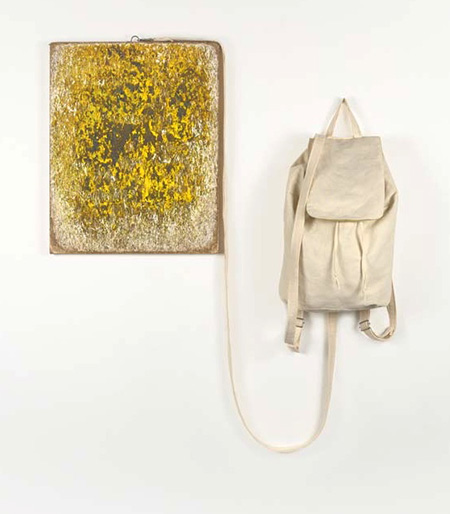
Continuing through December 22, 2018
Los Angeles readers may remember that Margie Livingston was the subject of the inaugural exhibition when Luis de Jesus Gallery opened in Culver City in 2011. Her current survey continues to re-invent the nature of painting. In each of her shows she presents a new and different way of approaching paint on canvas: ripping, tearing and shredding, for example. “Extreme Landscape Painting” is a love child of Robert Rauschenberg’s tire-track prints and Robert Ryman’s de-constructed canvas stretchers, Livingston extends both artists’ interventions.
Performance art enters into the equation in this body of work, with the artist hoisting the stretched, unpainted canvas onto a handmade “backpack” with a rope that drags the painting-to-be on the ground behind her one at a time. The results, scratched and colored slabs of wooden panel, are mounted on the wall next to their “backpacks,” originally worn by the artist during hikes and treks in the Pacific Northwest wilderness. A number of parodic elements are going on here: the regional obsession with nature in the wild; a religious devotion to painting, as if the artist were undergoing penitence on the trail; and the somber tradition of minimalism.
Livingston meets them all on their ground, taunting the seriousness of abstraction, turning it into a cartoon, a weekend hike, and its furious after-birth in the studio. Effective in groups, but weak when taken individually, Livingston’s paintings are too tied to their origins, insufficiently autonomous as stand-alone images. As such, contingency creates their meaning with prior events that threaten to outweigh aesthetic climax. That said, the small prints and paintings are joined by the “Color Studies” (2018), created by laps around the artist’s studio rather than from the sylvan sites. More amusingly, the “Dragged Sketchbooks” (2017-2018) take the planning stage further, spoofing intimate records that were themselves subjected, page by page, to dirt-trail hikes.
